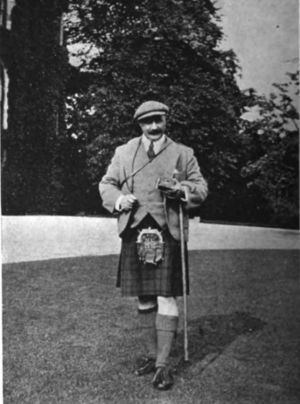Sir Charles Ross, 9th Baronet facts for kids
Quick facts for kids
Sir Charles Ross, 9th Baronet
|
|
|---|---|
 |
|
| Born |
Charles Henry Augustus Frederick Lockhart Ross
4 April 1872 Balnagown Castle, Scotland
|
| Died | 29 June 1942 (aged 70) St. Petersburg, Florida
|
| Education | Eton College |
| Occupation | Inventor, entrepreneur |
| Known for | Ross rifle |
| Spouse(s) |
Winifred Berens
(div. 1897)Patricia B. Ellison
(m. 1901; div. 1930)Dorothy Mercado
(m. 1938) |
Sir Charles Henry Augustus Frederick Lockhart Ross, 9th Baronet (born April 4, 1872 – died June 29, 1942) was a Scottish inventor and a smart businessman. He is best known for inventing the Ross rifle, a unique type of gun.
Contents
The Life of Sir Charles Ross
Sir Charles Ross was born in Balnagown Castle in Scotland. His father was Sir Charles William Frederick Augustus Lockhart-Ross, 8th Baronet. When his father passed away in 1883, Charles was just 11 years old. He then inherited the title of Baronet.
He went to Eton College, a famous school. While he was there, his mother made sure he had many luxurious things. These included a large ocean-going steam yacht and a big sailing yacht. He also had a fancy steam launch for river trips and a coach with four horses.
Later, when he became an adult, he had a disagreement with his mother. This was about how much money she had spent from his family's estates while he was young. He then attended Trinity College, Cambridge. Sir Charles was known for being a very good sharpshooter and a big game hunter.
Military Service and Inventions
Sir Charles became a lieutenant in the 3rd Battalion of the Seaforth Highlanders. He served in the Second Anglo-Boer War. During this war, he used his own invention, the Ross rifle. This gun was first used by his Machine Gun Battery.
From 1904 to 1913, he was a captain in the Lovat Scouts Yeomanry. He also advised the Canadian Government on small arms. He designed and built a power plant called the West Kootenay Power and Light Co. This plant was located on the Kootenay River at Bonnington Falls.
During World War I, his Ross rifle was made in large numbers for the Canadian army. After the war, sporting rifles with the Ross name were also popular. The .280 (about 7 mm) Ross sporting rifle cartridge was also well-liked.
Land and Legacy
Sir Charles Ross was said to be one of Britain's biggest landowners. He owned Scottish lands that covered about 366,000 acres (1,480 square kilometers). He had 3,000 people living on his lands.
At one point, he tried to avoid paying taxes in the United Kingdom. He declared his Balnagown estate in Scotland to be a territory of the United States of America. Because of this, the British Government considered him an outlaw for some time.
Sir Charles Ross was married three times. His first marriage to Winifred Berens ended in 1897. In 1901, he married Patricia Burnley Ellison, but they divorced in 1930. In 1938, he married his American secretary, Dorothy Mercado.
Sir Charles passed away at the age of 70 in St. Petersburg, Florida. Dorothy inherited Balnagown Castle after his death.
Today, Balnagown Castle is owned by businessman Mohamed Al-Fayed. He bought the castle in 1972 and has restored it. The castle is located near Invergordon in Scotland.
See also
- List of Cambridge University Boat Race crews
Other sources

